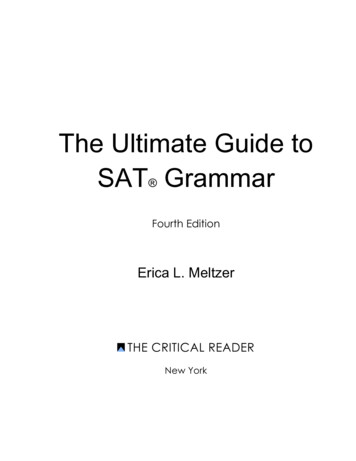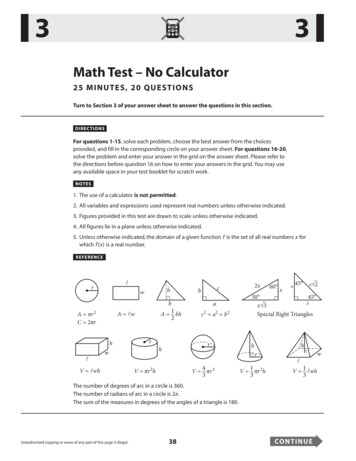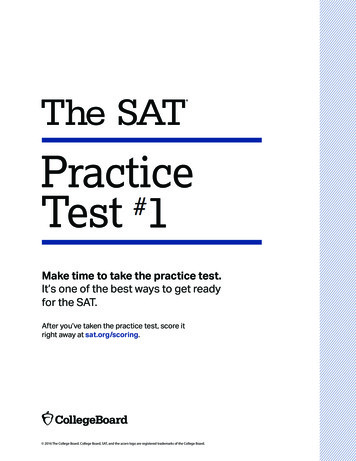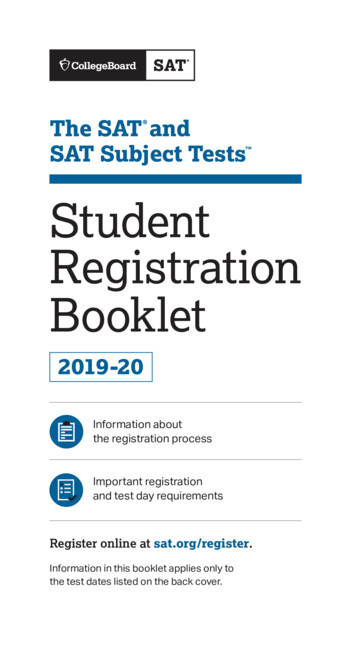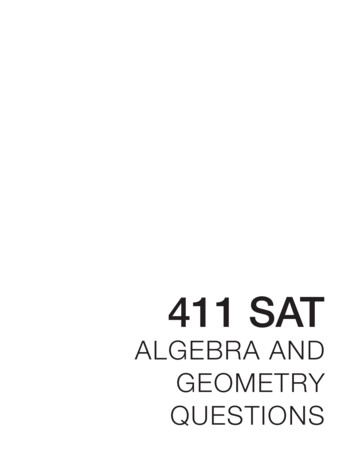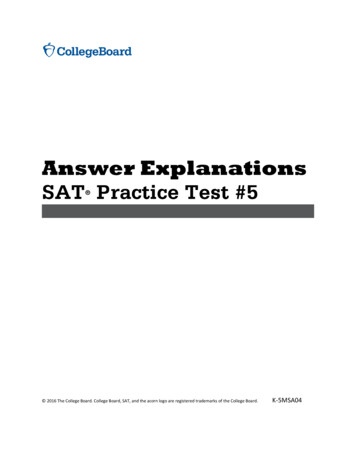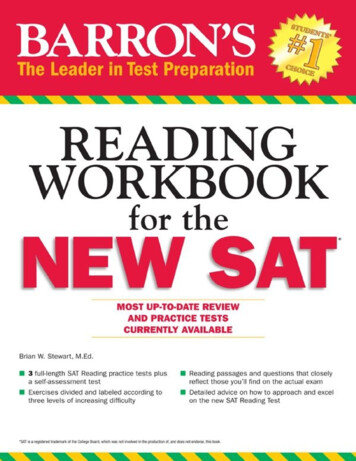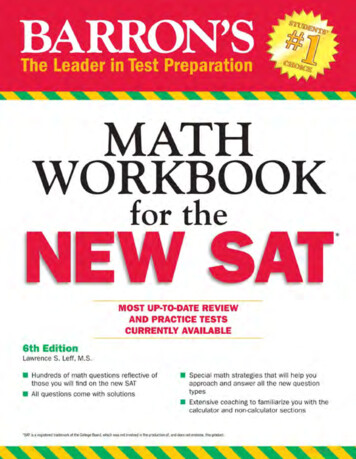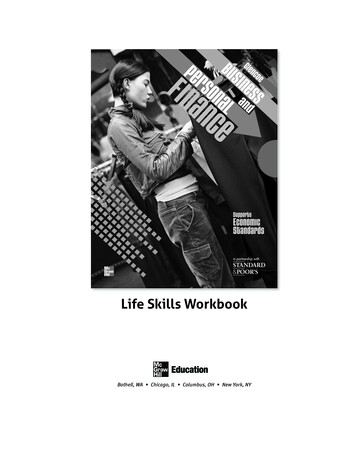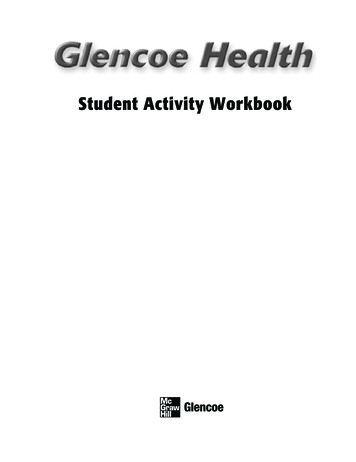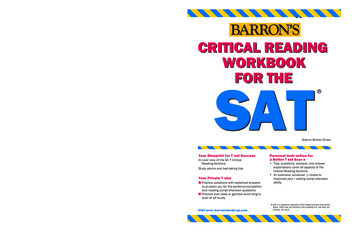
Transcription
7-3381-CRWB SAT-ufbs3/14/063:23 PMPage 1GreenSAT Choose Bar ron’s Method for Success on the SA T’s Critical Reading SectionsI Review the answers and explanations forall Level A questionsI Use the book’s vocabular y review tosharpen your r eading compr ehensionI When you have master ed Level Aexercises, pr ogress to Levels B and CI Do the Level A practice exer cises andscore your r esultsISBN-10: 0-7641-3381-0ISBN-13: 978-0-7641-3381-7SATI Read the Critical Reading over view andunderstand how the sections ar e scor edCRITICAL READING WORKBOOK FOR THECRITICAL READINGWORKBOOKFOR THEEAN It’s Your Path toa Higher T est Scor e 14.99 Canada 21.99www.barronseduc.comCRITICAL READINGWORKBOOKFOR THESAT Sharon Weiner Gr eenYour Blueprint for T est SuccessAn over view of the SA T CriticalReading SectionsStudy advice and test-taking tipsYour Private T utorI Practice questions with explained answersto pr epare you for the sentence-completionand reading compr ehension questionsI Practice exer cises or ganized accor ding tolevel of dif ficultyVisit www .barronstestpr ep.comPersonal Instr uction fora Better T est Scor e Tips, questions, answers, and answerexplanations cover all aspects of theCritical Reading Sections An extensive vocabular y review tomaximize your r eading compr ehensionability SAT is a registered trademark of the College Entrance ExaminationBoard, which was not involved in the production of, and does notendorse, this book.
7 3381 VerbalSAT FM12/2/054:43 PMPage iSATCRITICAL READING WORKBOOKFOR THE HOW TO PREPARE FOR THEGRADUATE MANAGEMENTADMISSION TEST12TH EDITIONMitchel W einerFormer Member , Depar tment of EnglishJames Madison High School, Br ooklyn, New Y orkSharon Weiner GreenFormer Instr uctor in EnglishMer ritt College, Oakland, California SAT is a registered trademark of the College Entrance Examination Board, which was not involved in the production of, and does not endorse, this book.
7 3381 VerbalSAT FM4/3/073:40 PMPage iiACKNOWLEDGMENTSThe authors gratefully acknowledge the following copyright holders forpermission to reprint material used in reading passages:Pages 113–114: From Picasso: The Early Y ears by Jiri Padrta. Undated.Tudor Publishing Co., New York.Page 4: From A Handbook to Literatur e, 6/E by Holman. 1992.Reprinted by permission of Prentice-Hall, Inc.Page 117: From “The Dynamic Abyss” by Charles D. Hollister, Arthur R.M. Nowell, and Peter A. Jumars. Copyright 1984 by Scientific American,Inc. All rights reserved.Pages 20–21: From “Symbolic Language of Dreams” by Erich Fromm inLanguage: An Enquiry into Its Meaning and Function by Ruth NandaAnshen, ed. Copyright 1957. HarperCollins Publishers, Inc.Pages 118–120: From Organizing the W orld’s Money by Benjamin J.Cohen. Copyright 1977. Basic Books, a div. of HarperCollins Publishers,Inc.Pages 26–27: From “The Spider and the Wasp” by Alexander Petrunkevitch.Copyright 1952 by Scientific American, Inc. All rights reserved.Pages 121–122: From F. Scott Fitzgerald by Kenneth Eble. Copyright1963. Twayne Publishers, an imprint of Simon & Schuster Macmillan.Page 30: From Small Town America by Richard Lingerman. Copyright 1980 with permission of Putnam Publishing Group.Page 31: From A Pocket History of the United States by Alan Nevins andHenry Steele Commager. Copyright 1991. Alfred A. Knopf, New York.Pages 93–94: From The Most Beautiful House in the W orld by WitoldRybczynski. Copyright 1989. With permission of Viking Penguin.Page 96: From La Vida by Oscar Lewis. Copyright 1965. Random House,New York.Pages 96–97: From “What is Poverty?” by Jo Goodwin Parker. Originallypublished in America’s Other Childr en: Public Schools Outside Suburbiaby George Henderson, ed. Copyright 1971. University of Oklahoma Press.Page 99: From “Living in Two Cultures” by Jeanne Wakatsuki Houston inOutlooks and Insights. Copyright 1983. St. Martin’s Press.Pages 100–101: Reprinted by permission from “Introduction” by AntonioCastro Leal to Twenty Centuries of Mexican Art. 1940 The Museum ofModern Art, New York.Pages 102–103: From The Press and the Pr esidency by John Tebbel andSarah Miles Watts. Copyright 1985. Oxford University Press, New York.Page 122: From “F. Scott Fitzgerald” by Edmund Wilson in Shores ofLight. 1985 with permission from Farrar, Straus & Giroux, Inc.Page 201: Reprinted by permission from Picasso: Fifty Years of His Art byAlfred H. Barr. 1946 The Museum of Modern Art, New York.Page 207: From The Magic Years by Selma H. Fraiberg. Copyright 1959.By permission of Scribner, a division of Simon & Schuster.Pages 207–208: From Essentials of Psychology and Life by Philip G.Zimbardo. Reprinted with permission of Addison-Wesley EducationalPublishers, Inc. Copyright 1980. Scott, Foresman and Co., Glenview,Illinois.Pages 222–223: From The Joy of Music by Leonard Bernstein. Copyright1959. Used by permission of Doubleday, a div. of BDD Publishing Group.Page 227: From “The Canopy of the Tropical Rain Forest” by Donald R.Perry. Copyright 1984 by Scientific American, Inc. All rights reserved.Page 232: From The Politics of Pr ejudice by Roger Daniels. Copyright1962. University of California Press, Berkeley.Page 105: From “The Desert Smells Like Rain: A Naturalist in PapagoIndian Country” by Gary Nabhan. With permission of North Point Press;div. of Farrar, Straus & Giroux, Inc.Pages 232–233: From “American Antisemitism Historically Reconsidered”by John Higham, in Jews in the Mind of America by Herbert Stember, et al,eds. Copyright 1966. American Jewish Committee, Basic Books, New York.Reprinted in Antisemitism in the United States by Leonard Dinnerstein, ed.Copyright 1971. Holt, Rinehart, and Winston, Inc., New York.Pages 107–108: “Native Earth,” from Indian Country by Peter Matthiessen,copyright 1979, 1980, 1981, 1984 by Peter Matthiessen. Used by permission of Viking Penguin, a division of Penguin Group (USA) Inc.Pages 246–247: From “The Man Who Hitched the Reindeer To SantaClaus’s Sleigh” by X. J. Kennedy in The New Y ork Times Book Review ,December 5, 1993. 1993 The New York Times Co.Pages 108–109: From “Social Characteristics and Socialization of WildChimpanzees” by Yukimaru Sugiyama in Primate Socialization by FrankE. Poirer, ed. Copyright 1972. Random House, New York.Page 251: From The Way to Rainy Mountain by N. Scott Momaday.Copyright 1969. University of New Mexico Press.Pages 110–111: From War, Peace and International Politics by David W.Zeigler, Copyright 1977. Reprinted by permission of Addison-WesleyEducational Publishers, Inc.Page 113: From Picasso on Art: A Selection of Views by Dore Ashton.Copyright 1972. The Viking Press, New York. Copyright 2006, 2005, 2001, 1997, 1994, 1990, 1987, 1983, 1979,1975, 1974, 1965 by Barron’s Educational Series, Inc.All rights reserved.No part of this book may be reproduced in any form, by photostat,microfilm, xerography, or any other means, or incorporated into anyinformation retrieval system, electronic or mechanical, without thewritten permission of the copyright owner.All inquiries should be addressed to:Barron’s Educational Series, Inc.250 Wireless BoulevardHauppauge, New York 11788http//www.barronseduc.comLibrary of Congress Catalog Card No. 2006040766ISBN-13: 978-0-7641-3381-7ISBN-10: 0-7641-3381-0Pages 252–253: From “Huge Conservation Effort Aims to Save VanishingArchitect of the Savanna” by William K. Stevens, 1989 by The NewYork Times Co. Reprinted with permission.Page 256: From Montana 1948 by Larry Watson. Copyright 1993 byLarry Watson. (Milkweed Editions, 1993)Library of Congress Cataloging-in-Publication DataWeiner, Mitchel, 1907Barron’s critical reading workbook for the SAT / Mitchel Weiner,Sharon Weiner Green.—12th ed.p.cm.Rev. ed. of: Barron’s verbal workbook for the new SAT. 11th ed.c2005.ISBN-13: 978-0-7641-3381-7ISBN-10: 0-7641-3381-01. English language—Examinations—Study guides.2. Universities and colleges—United States—Entrance examinations—Study guides. 3. SAT (Educational test)—Study guides.I. Title: Critical reading workbook for the SAT. II. Green, Sharon,1939- III. Title.LB1631.5.W45 2006378.1'662—dc22Printed in the United States of America9 8 7 6 5 4 32006040766
7 3381 VerbalSAT FM12/2/054:43 PMPage iiiCONTENTSPREFACEvPART IINTRODUCING THE SAT:CRITICAL READING SKILLSNature of the Test 3Overview and Content 3The Critical Reading Sections 4Sentence Completion Questions 4Reading Comprehension Questions 4Before the Test 5Six Months Before 5Two Months Before 5The Night Before 7During the Test 8Use Time Wisely 8Center on the Test 9PART IISELF-ASSESSMENTIntroduction 13Self-Assessment Test 17Answer Key 34Analysis of Test Results 35Answer Explanations 37PART IIISENTENCE COMPLETION QUESTIONSOverview 43Tips on Handling Sentence Completion QuestionsBefore You Look at the Answer Choices, Think of aWord That Makes Sense 43Spot Clues in the Sentence: Signal Words 44Notice Negatives 45Words Have Many Meanings: Stay Alert 45Break Down Unfamiliar Words, Looking forFamiliar Word Parts 46Take One Blank at a Time 46Sentence Completion Exercises 47Level A 47Level B 56Level C 64Answers to Sentence Completion Exercises 73Answer Explanations 7543
7 3381 VerbalSAT FMiv12/2/054:43 PMPage ivCRITICAL READING WORKBOOK FOR THE SATPART IVREADING COMPREHENSION QUESTIONSOverview 87Tips on Handling Reading Comprehension QuestionsTry to Anticipate What the Passage Is About 88Pick Your Questions to Answer 88Read Purposefully: Passage, Questions, andAnswer Choices 88Go Back to the Passage to Double-Check YourAnswer Choices 89Tackle Paired Passages One Passage at a Time 89Reading Comprehension Exercises 90Level A 90Level B 107Level C 115Answers to Reading Comprehension Exercises 124Answer Explanations 125PART VBUILDING YOUR VOCABULARYOverview 137Tips on Building Your Vocabulary 137Read Widely to Develop Your Feeling for Words 137Use Memory Tricks to Keep New Words in YourActive Vocabulary 138Acquaint Yourself with Word Parts—Prefixes, Suffixes,Roots—to Expand Your Vocabulary 138Work Through the SAT High-Frequency Word Listto Expand Your College-Level Vocabulary 138SAT High-Frequency Word List 139Basic Word Parts 171PART VITESTS FOR PRACTICECritical Reading Test 1 193Answer Key 211Analysis of Test Results 212Answer Explanations 213Critical Reading Test 2 219Answer Key 235Analysis of Test Results 236Answer Explanations 237Critical Reading Test 3 243Answer Key 260Analysis of Test Results 261Answer Explanations 26288
7 3381 VerbalSAT FM12/2/054:43 PMPage vPREFACEWelcome to the world of the SAT, where airand lumber can be verbs, and apathy and phenomena are common everyday words. Welcome to thetwelfth edition of Barron’s Critical ReadingWorkbook. If you are preparing for the criticalreading sections of the SAT, this is the book youneed. It features four complete critical reading tests,each three sections long. Here are four crucial“dress rehearsals” for the day you walk into theexamination room. It briefs you on the vocabulary-in-context andreading comprehension questions, giving youkey tips on how to tackle these important typesof questions. It takes you through the double reading passages,showing you how to work your way througha pair of passages without wasting effort ortime. It offers you enough material for a year-longstudy program so that you don’t have to settle forlast-minute cram sessions. Pace yourself as youwork your way through the wealth of practiceexercises designed for you. It gives you the SAT High-Frequency Word List,incorporating vocabulary from actual SAT teststhrough 2005. These words are vital—computeranalysis shows that they occur test after test onactual SATs. Master them, and you’ll be well onyour way to building a college-level vocabulary.With dozens of clear, helpful pointers and hundreds of brand-new questions modeled closely onquestions appearing on today’s SAT, Barron’s CriticalReading Workbook gives you a down-to-earth introduction to the sometimes intimidating world of theSAT. Don’t let the SAT get you down. With theBarron’s team behind you, go for your personal best:take time today to build your skills for the SAT.This twelfth edition of Barron’s CriticalReading Workbook is a sign of Barron’s ongoingcommitment to make this publication America’soutstanding guide to the critical reading sections ofthe SAT. It has benefited from the dedicated laborsof the editorial staff of Barron’s, in particular LindaTurner and Ruth Flohn, and from the research andwriting skills of Lexy Green. We are greatlyindebted to them.v
7 3381 VerbalSAT FM12/2/054:43 PMPage vi
7 3381 VerbalSAT Part112/2/054:44 PMPARTPage 1IINTRODUCINGTHE SAT:CRITICAL READINGSKILLSNature of the TestOverview and ContentThe Critical Reading SectionsBefore the TestDuring the Test
7 3381 VerbalSAT Part112/2/054:44 PMPage 2
7 3381 VerbalSAT Part112/2/054:44 PMPage 3OVERVIEW AND CONTENT3NATURE OF THE TESTThe SAT is a standardized test designed to help predict how well you are likely to do in your academicwork as a college freshman. By looking at yourschool grades and your SAT scores, college admissions officers get a sense of you as a potential student—a person they’d like to have in their school.The SAT tries to measure your ability to reasonusing facts that are part of your general knowledgeor facts that are included in your test booklet.You’re not required to recall great chunks of historyor literature or science. You’re not even required torecall most math formulas—they’re printed right inthe test booklet.Assessment tests are essentially multiplechoice tests. Your score depends upon how manycorrect answers you get within a definite period oftime. Speed is important, but so is accuracy. Youhave to pace yourself so that you don’t sacrificespeed to gain accuracy (or sacrifice accuracy togain speed).OVERVIEW AND CONTENTThis is the actual format of the SAT. The total testing time allowed is 33 4 hours. There are ten sectionson the test. You are given 25 minutes apiece tocomplete seven of them. They are: 1 essay-w
Answer Key 211 Analysis of Test Results 212 Answer Explanations 213 Critical Reading Test 2 219 Answer Key 235 Analysis of Test Results 236 Answer Explanations 237 Critical Reading Test 3 243 Answer Key 260 Analysis of Test Results 261 Answer Explanations 262 iv CRITICALREADING WORKBOOK FOR THE SAT 7_3381_VerbalSAT_FM 12/2/05 4:43 PM Page iv
